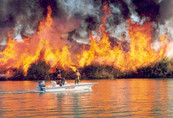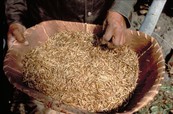|
Volume 5 - November 2020
Traditional Ecological Knowledge
Traditional Ecological Knowledge (TEK) refers to the evolving knowledge acquired by Indigenous and local peoples over hundreds or thousands of years through direct contact with the environment. In this month's issue of the Reader, we're highlighting articles that explore TEK practices for ecosystem management, including wilderness and moose management, and collaborative environmental stewardship.
The content is timely, with Governor Walz's Executive Order to expand Tribal-State relations in Minnesota, and there are numerous resources on TEK efforts that are relevant to land and resource management in Minnesota. For instance, this new report from a group of tribal nations, federal agencies and other entities highlights the importance of Manoomin (wild rice) in the Lake Superior Basin and throughout the Great Lakes. This new series from the International Joint Commission focuses on the potential of Indigenous Knowledge to strengthen water management. Additionally, this tribal climate adaptation menu was created by a collaboration of scientists, managers, landowners and tribal partners to better reflect Indigenous perspectives and knowledge in climate change adaptation planning.
Our federal partners are also active in including TEK efforts in their management. This brief article describes how the U.S. Fish and Wildlife Service incorporates TEK into its work. The National Park Service has a dedicated website to TEK that has loads of additional resources for you to explore.
We hope you enjoy this issue of the Reader and perhaps it will spark ideas on how to incorporate TEK into your work.
The Minnesota Research Reader is a collaboration between the Minnesota Department of Natural Resources and the USDA Forest Service that is intended to provide a quick look at emerging research relevant to our work in the State of Minnesota. Thank you for taking the time to consider the implications of the research presented in this edition of the Reader.

One of the most cited articles on Traditional Ecological Knowledge (TEK) is from Fikret Berkes, an applied ecologist with the National Resources Institute at the University of Manitoba. Published in Ecological Applications, this research explores the alternative knowledge and perspectives from Indigenous groups on local resource use. This study surveyed international TEK literature and found there is a diversity of local and traditional practices for ecosystem management through a variety of ecological, social, institutional and cultural mechanisms. Traditional systems had certain similarities to adaptive management, with its emphasis on feedback learning and its treatment of uncertainty and unpredictability intrinsic to all ecosystems.
Management Implications:
- Local Indigenous knowledge can help monitor, interpret and respond to dynamic changes in ecosystems and the resources and services they generate.
- There are several management practices based on local ecological knowledge that range from monitoring specific resources to sophisticated practices that respond to and manage disturbance and build resilience.
- Social mechanisms behind Indigenous knowledge provide for the qualitative management of resources and ecosystems, and for parallels to adaptive management.
|

This study by Jesse Popp, from Laurentian University and Mount Allison University in Canada and published in Human Dimensions of Wildlife, follows moose management efforts in Canada that include Indigenous knowledge in conservation and management planning. Although plans like this are increasing in number, they are still limited. The article emphasizes how wildlife management has benefitted from TEK integration.
Management Implications:
- Wildlife management can benefit from integrating TEK through co-management initiatives involving tribal members, offering a holistic approach to conservation and management planning.
- The sustainability of Minnesota’s moose population continues to be a concern for federal, state, and tribal wildlife managers. This article demonstrates that incorporating TEK has contributed to the success of several moose management initiatives across Canada by helping to fill the gaps in scientific understanding.
- Strengthened communication and respect among Indigenous and non-Indigenous collaborators can encourage a knowledge sharing system that improves localized monitoring of population change, thereby supporting appropriate management decisions that directly benefit moose conservation.
|

This study, by Evan Larson and his collaborators from the University of Minnesota and freshly published in the Annals of the American Association of Geographers, examines how the area that is now the BWCAW was significantly altered by Native Americans who promoted the growth of big pine forests through intentional fire. When the BWCAW was established, it was to maintain these pine forests “in a wild, untouched state.” An opportunity exists for wilderness managers, users and advocacy groups to reassess the need for active management and the strategic return of frequent fire to the aging pine forests of the BWCAW, which were managed for years by local Indigenous populations. Engaging descendent communities of the Border Lakes Anishinaabeg in these efforts could help move beyond conventional approaches to wilderness management and restore the reciprocal relationship between people, fire, and red pine in the BWCAW and beyond. This partnership between the National Park Service and the Bureau of Indian Affairs is an example of restoring the cultural landscape through prescribed fire at the Apostle Islands National Lakeshore.
Management Implications:
- Policies instated to protect natural landscapes, in this case the 1964 Wilderness Act, can contribute to the decline of those very ecosystems by ignoring or excluding the human element that contributed to their presence on the landscape.
- Opportunities exist for wilderness managers, users and advocacy groups to reassess the need for active management and the strategic return of frequent fire to the aging pine forests of the BWCAW and other protected areas on the Minnesota landscape.
- Engaging tribal members and utilizing Traditional Ecological Knowledge in decision-making could help restore imperiled species, habitats and processes on the landscape and restore the reciprocal relationship between people and natural systems.
|

This article led by Nicholas Reo, interdisciplinary scholar from Dartmouth College focused on the human-environment interactions of Indigenous peoples, and published in AlterNative: An International Journal of Indigenous Peoples, investigates multi-actor collaborations and environmental initiatives that involve Indigenous nations. Data were collected through interviews of 39 representatives of regional partnerships involving Indigenous nations from the Great Lakes basin of North America, to determine factors that enable Indigenous partners to remain engaged in multi-actor collaborations. In voluntary partnerships focused on environmental protection and stewardship, participants hope to care for the environment with common ground to build upon. But deeper cross-cultural understanding, such as the culturally specific motivations of stewardship, is required to sustain partnerships.
Management Implications:
- The collaboration literature signals that engagement with Indigenous partners reveals, and may reinforce, obstacles to Indigenous participation in multi-actor environmental initiatives.
- Six characteristics influenced Indigenous nations’ willingness to remain engaged: respect for Indigenous Knowledge, control of knowledge mobilization, intergenerational involvement, self-determination, continuous cross-cultural education and early involvement.
- Recognizing these factors can help partnerships achieve their environmental goals, by keeping important partners at the table.
|
|